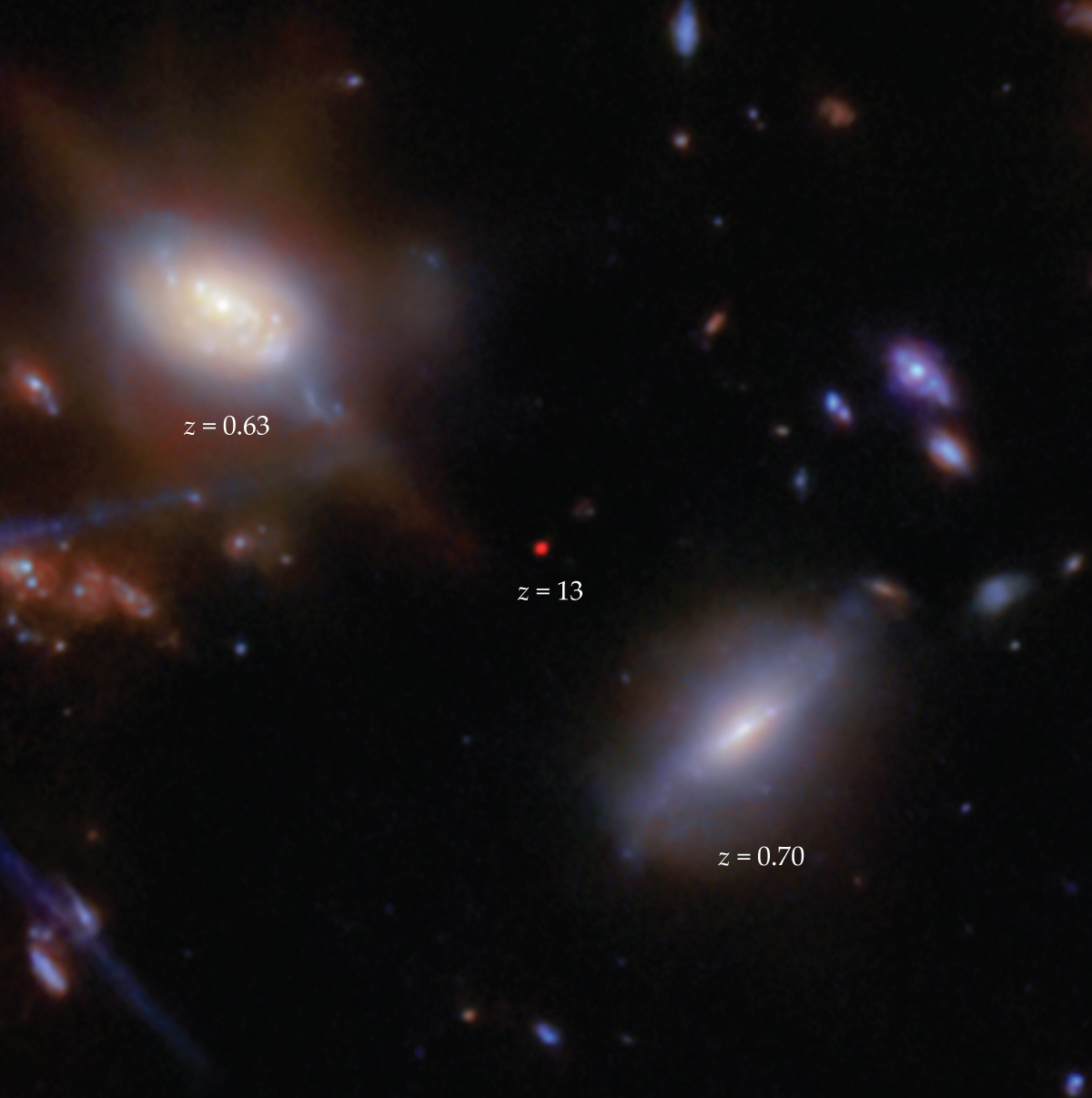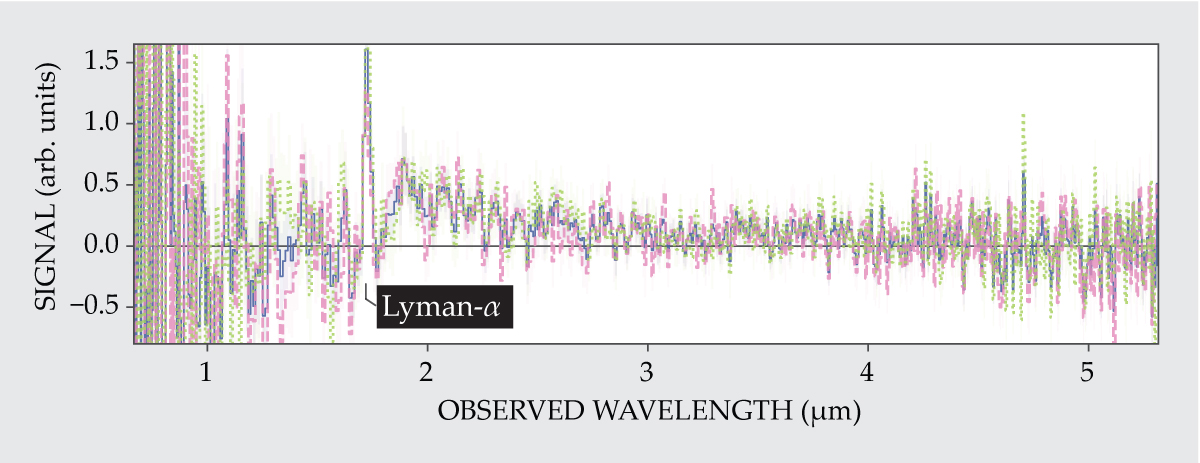A small ancient galaxy started reionizing its surroundings early
DOI: 10.1063/pt.lall.cjjt
In the context of the universe, the matter around us is unusual: It’s made up of neutral atoms. Of all the baryonic matter in existence (that is, disregarding dark matter and dark energy, whose forms are unknown), the vast majority is ionized. Much of the ionized matter is in stars—more than 99% of the mass of our solar system is in the Sun—and even more is in the intergalactic medium (IGM), the desolate expanse between galaxies with a matter density as low as a single atom per cubic meter.
Or rather, because the IGM is mostly hydrogen and overwhelmingly ionized, each cubic meter contains not a bound-state atom but a lone proton and a lone electron, doomed to forever search for one another in the emptiness of space. Because intergalactic distances are so vast, the particles with that lonely fate represent the majority of all baryonic matter.
Their situation used to be different. Neutral hydrogen was the norm for hundreds of millions of years in the early history of the universe. Protons and electrons combined into atoms at the same time that the cosmic microwave background formed, some 380 000 years after the Big Bang, and they remained stable until stars were consistently producing enough light to ionize them all again.
Reionization—the last phase transition that the universe underwent as a whole—didn’t happen everywhere at the same time, but it was thought to have been a fairly quick process, cosmologically speaking: beginning 600 million or 700 million years after the Big Bang and wrapping up by 1 billion years after the Big Bang. Now, however, Joris Witstok (of the Cosmic Dawn Center at the University of Copenhagen) and colleagues have found evidence in data from the James Webb Space Telescope (JWST) that reionization started as early as 330 million years after the Big Bang, at least in the vicinity of one galaxy they observed. 1
The observation is just one data point. But it contains valuable clues about the kinds of galaxies that got reionization started—and the kinds of stars that they may have contained.
Intergalactic ions
Astronomers know that the IGM must be ionized because they can see so clearly through it. If the IGM were a gas of neutral atomic hydrogen, it would absorb strongly at the characteristic wavelengths—the Lyman series—that correspond to the excitation energies from hydrogen’s ground state to its infinitely many excited states.
In the rest frame, Lyman-series resonances are all in the UV. They start at 122 nm, the Lyman-α excitation to the first excited state, and they converge to the Lyman limit at 91 nm. Photons with still shorter wavelengths have enough energy to rip hydrogen atoms apart.
Over cosmic distance scales, though, the picture is complicated by the fact that the universe is expanding. When light travels for billions of years from a distant galaxy, its wavelength is stretched, or redshifted, by the time it’s seen by an Earthly observer. For a galaxy with a redshift of z = 3—meaning that its light gets stretched by a factor of z + 1 = 4—its Lyman-α resonance shows up not at 122 nm but at 486 nm. Along the way, it traverses the whole continuum between those wavelengths. If all of space were filled with Lyman-α-absorbing hydrogen atoms, that whole swath of the galaxy’s spectrum would be wiped out.
Figure 1.

Galaxies at many distances appear together in the images captured by the James Webb Space Telescope. They’re distinguished by the wavelengths at which they appear: The galaxy shown as the red dot in the center of the image is so old that the expansion of the universe stretched the visible and UV light it emitted all the way into the IR. Its redshift, z = 13, means that we see it today as it existed 330 million years after the Big Bang. (Image by ESA/Webb, NASA & CSA, JADES collaboration, J. Witstok, P. Jakobsen, A. Pagan/STScI, and M. Zamani/ESA/Webb.)

That’s not what astronomers see. Plenty of UV and blue light reaches Earth from z = 3 sources. Their spectra are attenuated by a thicket of discrete absorption lines, called the Lyman-α forest. But that’s what’s expected of light that’s passed through many isolated patches of neutral gas—which are known to exist, especially in and around galaxies—rather than through a continuous neutral IGM.
Above a redshift of about 6—more than 13 billion years ago, or less than 1 billion years after the Big Bang—the situation changes. The observed spectra of such ancient, distant sources do have regions, just blueward of their redshifted Lyman-α resonances, where their light is completely absorbed (see Physics Today, October 2001, page 17
Why the difference? So early in the universe’s history, starlight—specifically, the UV light capable of ionizing hydrogen atoms—was much scarcer than it is today because the epoch of peak star formation was still a couple of billion years in the future. At the same time, the universe was smaller, so intergalactic hydrogen was denser, and it was easier for protons and electrons to find one another and pair up. In the competition between the Coulomb forces that drive atoms to form and the ionizing radiation that rips them apart, the former used to have the edge. Now the latter does.
Hunting early galaxies
The end of the reionization transition had been observed in the early 2000s, but looking back much deeper into the transformation’s history had to wait for the advent of the JWST. Above a redshift of about 7, the Lyman-α wavelength is stretched so far into the near-IR that it runs into atmospheric absorption bands, so it can’t be observed with ground-based telescopes. The Hubble Space Telescope, too, was optimized for observing in the visible range, not the IR. “Purely, this was possible only because of JWST’s instrumentation,” says Witstok. “We need instruments that can work at long wavelengths, and we need JWST’s huge 6-meter mirror because the galaxies are so incredibly faint.”
Roughly speaking, the JWST observation process has two stages. In the first, the telescope captures images of an entire swath of sky, including the region shown in figure
Through that method, JWST observers have identified several candidates for extremely early galaxies.
2
Among them was the red dot in the middle of figure
From the spectra, shown in figure
What was completely unexpected, however, was that at the Lyman-α wavelength itself, the spectrum showed a sharp, intense peak. If the galaxy had been surrounded by a neutral IGM, such an emission would have been immediately absorbed and would never have reached Earth. For a z = 13 galaxy to exhibit the spectrum that the researchers observed, it would have to have been surrounded by a sizable reionized region so that its light would not have encountered any neutral IGM until its Lyman-α emission spike was safely redshifted out of reach.
Small and mighty
The natural explanation for how a z = 13 galaxy came to be surrounded by reionized IGM is that it performed the reionization itself. If so, that’s an important clue about the types of galaxies that were responsible for reionization. The z = 13 object is extremely compact, with an estimated radius of tens of parsecs. In contrast, the Milky Way’s radius is thousands of parsecs. “There’s a debate over whether reionization was due to many smaller galaxies or fewer big ones,” says Witstok. “This points toward smaller galaxies, which could exist earlier on.”
The observation also raises the question of how the galaxy generated such an intense Lyman-α emission in the first place. “It doesn’t line up with our standard models of stars,” says Witstok. Even without encountering a neutral IGM, he points out, between 90% and 95% of the Lyman-α light was likely absorbed on its trip toward Earth. “So it must have started out incredibly luminous. Something in that galaxy is very powerful—maybe hot massive stars, or maybe a black hole that’s accreting.”
Figure 2.

The IR spectrum of the z = 13 galaxy from figure

The earliest stars and galaxies must have been different from the ones that formed more recently because they formed from different material. Stars such as our Sun were forged from the leftovers of previous generations of stars, and they contained a mix of chemical elements from the start. But the universe’s first generation of stars, known to astronomers as Population III, formed directly out of the primordial material that emerged from the Big Bang: mostly hydrogen, a little helium, and a trace of lithium. And their formation process would have been qualitatively different.
Perhaps counterintuitively, the first step toward star formation is cooling: For a mass of material to coalesce to the density needed to trigger nuclear fusion, it needs to shed its excess energy. That happens through collision and radiation: Atoms collide, promote one another into excited states, and relax back to the ground state by hurtling photons out into space. The process is much easier with some heavier elements, such as carbon and oxygen, in the mix because of their rich spectra of low-energy excited states. To radiatively cool a gas of just hydrogen, the collisions would have to pack enough of a punch to excite the Lyman-α transition—a tall order.
Population III star formation has never been observed directly. All that researchers have are computer models of how the process would have played out and what the resulting stars would have looked like. The models suggest that Population III stars would have been much hotter and more massive than the Sun, and they would have shone brightly at the Lyman-α wavelength. Although the resemblance to the z = 13 object is tantalizing, it’s far too tenuous a case for the researchers to conclude that that’s what they’ve observed.
Whatever the Lyman-α was inside the z = 13 galaxy, it had an influence on the universe far beyond its galactic home: The researchers estimate that the ionized region around the galaxy must have had a radius of at least 200 000 parsecs. The connection across scales—from the hot, dense environment of stars and black holes to the enormous desolation of intergalactic space and ultimately the universe as a whole—is what Witstok finds inspiring about reionization. “It’s a very important transition that the universe goes through, and it’s controlled by the physics of how stars form inside galaxies,” he says. “It’s important to understand how these processes connect from one scale to another.”
This article was originally published online on 24 April 2025.
References
1. J. Witstok et al., Nature 639, 897 (2025).https://doi.org/10.1038/s41586-025-08779-5
2. See, for example, B. Robertson et al., Astrophys. J. 970, 31 (2024).https://doi.org/10.3847/1538-4357/ad463d
More about the Authors
Johanna L. Miller. jmiller@aip.org
